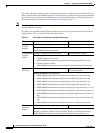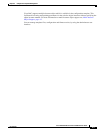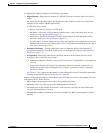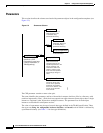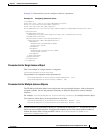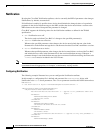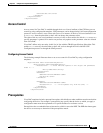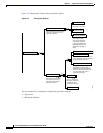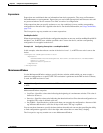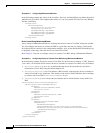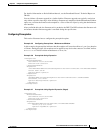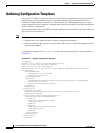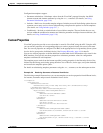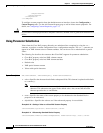
5-9
Cisco Broadband Access Center 3.8 Administrator Guide
OL-27172-01
Chapter 5 Configuration Templates Management
Features of Cisco BAC Templates
<Value>www.sbc.com</Value>
</Parameter>
</ObjectInstance>
</ObjectInstance>
Access Control
Access control in Cisco BAC is enabled through the AccessControl attribute of the CPE that you can
control by using configuration templates. CPE parameters can be changed using LAN autoconfiguration
protocol if access control is set to allow such access. For instance, if the AccessControl attribute is set
to
Subscriber, then the subscriber on the LAN can change the parameter value.
The value of the AccessControl attribute is an array of zero or more entities for which
write access to a
specific parameter is granted. If no entries are present, only updates to the parameter value are allowed
from Cisco BAC.
Cisco BAC defines only one entity in this list, in line with the TR-069 specification: Subscriber. This
enables
write access by the subscriber on the LAN, such as through the LAN-side DSL CPE
Configuration protocol or through the UPnP protocol.
Configuring Access Control
The following example illustrates how to set access control in Cisco BAC by using configuration
templates:
<ObjectInstance name="InternetGatewayDevice">
<ObjectInstance name="ManagementServer">
<AccessControl> <!--Allow LAN-side updates of this object and parameters
under it -->
<Entity>Subscriber</Entity>
</AccessControl>
<Parameter>
<Name>PeriodicInformEnable</Name>
<Value>true</Value>
</Parameter>
<Parameter>
<Name>PeriodicInformEnable</Name>
<AccessControl/> <!-- Allow updates only from ACS (BAC) -->
</Parameter>
</ObjectInstance>
</ObjectInstance>
Prerequisites
Cisco BAC templates include a prerequisites option, which indicates what conditions must be met before
configuring the device. For example, a prerequisite may specify that the device to which you apply a
configuration must meet the requirement of a specific hardware or software version.
Prerequisite rules are embedded into an instruction, which is sent to the DPE. The DPE then interrogates
the device as necessary to determine if the prerequisites match.




